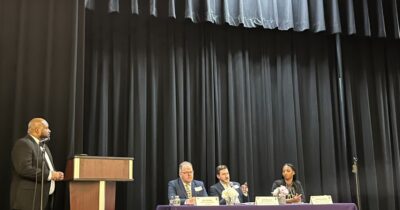-by Brian Payne
president and CEO of CICF
and president of The Indianapolis Foundation
We want the residents of Central Indiana to be successful, content and happy.
There is a fascinating article that appeared in a 2011 issue of Urban Affairs Review that explains what that takes:
Cities that provide easy access to convenient public transportation and to cultural and leisure amenities promote happiness. Cities that are affordable and serve as good places to raise children also have happier residents. We suggest that such places foster the types of social connections that can improve happiness and ultimately enhance the attractiveness of living in the city.
This knowledge is at the heart of Central Indiana Community Foundation’s (CICF) inspiring places community leadership initiative. It is why making art, beauty, nature and high-quality amenities accessible to everyone in Central Indiana is so important to us. We don’t advocate for green spaces and public art solely for their own sake—though beauty is important. The environment where we live is intrinsically tied to our well-being. (We heard this from nearly all of our community ambassadors last year.)
Our leadership in this area is why CICF is often asked to sit at the table with civic leaders, urban planners, architects, neighborhood advocates and others when the region responds to projects, like the proposed I-70/I-65 split. The Indiana Department of Transportation (INDOT) has introduced a $250 million preliminary plan to repair and rebuild some of our deteriorating 50-year-old highway infrastructure, widening bridges and byways, and adding concrete walls. Repairs to this infrastructure are sorely needed, but the current plan threatens to damage the quality of life in some of the city’s historic and underserved neighborhoods—adding pollution, noise and traffic, and a wider and darker physical barrier between these neighborhoods and downtown, downtown and these neighborhoods.
We know better now, and we have to do better.
Mid-20th century, federally-backed highway projects—like the ones that gave Central Indiana much of its highway system—were notorious for disadvantaging vulnerable citizens, especially people of color, and destroying their neighborhoods. (Read this excellent article in The Atlantic or pick up a favorite book of mine by Jane Jacobs, The Death and Life of Great American Cities.)
We know better now, and we have to do better.
CICF is advocating for a full study of alternatives to INDOT’s plan. The plan that prepares Central Indiana highways for the next half century cannot create or compound inequity and disconnection. Connectivity is the main ingredient for success in the 21st century. This project has to be bold, visionary and prioritize the needs of people over cars.
Enhancements to infrastructure should not come at the expense of the community’s most vulnerable populations or its now thriving historic neighborhoods. This idea squares with our new strategic direction centered on equity and opportunity. You’ll learn more about it in the coming months. But influencing how this region handles infrastructure and its impact on communities is part of that work. We are committed to working alongside individual, neighborhood and community partners to dismantle barriers and build more pathways for everyone to reach their full potential. Pathways—not just highways.
The future success (and happiness) of our community depends on it.






I am so thankful to know that CICF is advocating for a review of infrastructure alternatives. Your voice is needed and trusted, AND I am looking forward to hearing about your new strategic direction.
This message is right on and needs to be said over and over. Thank you, Brian Payne.
Thank you Brian and CICF for elevating this discussion and taking this stand. It is imperative that the threat to historic and challenged neighborhoods posed by “infrastructure from above” be recognized, mitigated, and adapted, and not allowed to further erode community connectivity in Indianapolis. We still wrestle daily with the legacy of the unwise decisions of the 1960s. Let’s avoid doubling down on those mistakes when we know better. Thank you for championing this important effort.
the racist history of urban renewal still plagues american cities, including the widespread proliferation of ubiquitous subsidized parking and highway systems. good urban planning is working to address more equitable visions of the future, including advocating for more connected communities. These photographic aerial images of the last 60 years of change in midwestern cities is astounding: http://iqc.ou.edu/2014/12/12/60yrsmidwest/ kudos to mr. Payne and cicf for challenging indot on its practices and priorities.